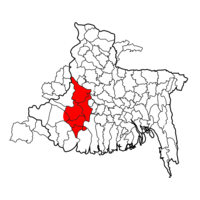
The Khulna Division is the second largest of the eight divisions of Bangladesh. It has an area of 22,285 km2 (8,604 sq mi) and a population of 17,416,645 at the 2022 Bangladesh census. Its headquarters and largest city is Khulna city in Khulna District.

Nadia is a district in the state of West Bengal, India. It borders Bangladesh to the east, North 24 Parganas and Hooghly districts to the south, Purba Bardhaman to the west, and Murshidabad to the north.

Ghoti is a term used to refer a social group of Bengali people native to the Indian states of West Bengal and Jharkhand. The term is used to describe Bengalis from the west, as opposed to the Bangals of Eastern Bengal now Bangladesh.

Kushtia District is a district in the Khulna administrative division of western Bangladesh. Kushtia is the second largest municipality in Bangladesh and the eleventh largest city in the country. Kushtia has existed as a separate district since the partition of India. Prior to that, Kushtia was name of a subdivision of Nadia district. Kushtia is the birthplace of many historical figures including Mir Mosharraf Hossain (1847–1912), Bagha Jatin (1879–1915) and Lalon (1774–1890). Nobel laureate poet Rabindranath Tagore lived his early life at Shelaidaha, a village in the district.

The Geography of West Bengal, a state in eastern India, is primarily defined by plains and plateaus, with the high peaks of the Himalayas in the north and the Bay of Bengal to the south.
The Battle of Kushtia was a battle between the Irregular Bengali Guerrillas including Policemen against the Pakistan Army in March and April 1971, The battle was fought by the Mukti Fauj and the 27th Baluch Regiment of the Pakistan Army.
Jagadanandapur is a census town in the Nakashipara CD block in the Krishnanagar Sadar subdivision of the Nadia district in the Indian state of West Bengal,and the town is part of Bethuadahari 1 G.P.

The Bengali dialects or Bengali varieties are the varieties of the Bengali language, an Eastern Indo-Aryan language of the Indo-European language family, widely spoken in the Bengal region of South Asia. The spoken dialects of Bengali are mutually intelligible with neighbouring dialects.

Aranghata is a village and a gram panchayat in the Ranaghat II CD block in the Ranaghat subdivision of the Nadia district, West Bengal, India. It is situated 78 km (48 mi) north of Calcutta and about 9 km (5.6 mi) north of Ranaghat town.

Hanskhali is a village in the Hanskhali CD block in the Ranaghat subdivision of the Nadia district in the state of West Bengal, India. Situated on the bank of the Churni river, Hanshkhali is known for an Administrative Registry Office and Police Station.

Bengali, also known by its endonym Bangla, is a classical Indo-Aryan language from the Indo-European language family native to the Bengal region of South Asia. With over 237 million native speakers and another 41 million as second language speakers as of 2024, Bengali is the fifth most spoken native language and the seventh most spoken language by the total number of speakers in the world. It is the fifth most spoken Indo-European language.

The Bengali script or Bangla alphabet is the alphabet used to write the Bengali language based on the Bengali-Assamese script, and has historically been used to write Sanskrit within Bengal. It is one of the most widely adopted writing systems in the world . It is one of the official scripts of the Indian Republic. It is used as the official script of the Bengali language in Bangladesh, West Bengal, Tripura, and Barak valley of Assam Until recently, it was the usual script for the Meitei language in Manipur, but is being replaced by Meitei mayek. two of the official languages of India.
Dandabhukti was an ancient and medieval territory located between the two rivers, Dwarakeswar and Subarnarekha, and situated in the Rarh region of the ancient Bengal. It covered the present-day districts of Bankura, Hooghly, Paschim Medinipur, and Purba Medinipur in West Bengal, India.

Kolaghat is a community development block that forms an administrative division in Tamluk subdivision of Purba Medinipur district in the Indian state of West Bengal.

Khejuri II is a Community Development Block that forms an administrative division in Contai subdivision of Purba Medinipur district in the Indian state of West Bengal.

The Sealdah–Ranaghat–Gede line connects the Sealdah Main and North terminus of Kolkata with Ranaghat and Gede of Nadia district of West Bengal, India. Once a part of the old Calcutta–Siliguri main line, today it is a busy suburban section of the Kolkata Suburban Railway's Sealdah North section connecting the North 24 Parganas and Nadia districts with Kolkata. It is under the jurisdiction of the Sealdah railway division of the Eastern Railway zone of the Indian Railways.
Darsana is a small industrial township and municipality in the southwestern region of Khulna Division, Bangladesh.

Bengal temple architecture is about temple styles developed and used in Bengal, particularly the chala, ratna and dalan temples.
Bishnupur is a village in the Krishnanagar I CD block in the Krishnanagar Sadar subdivision of the Nadia district in the state of West Bengal, India.

Undivided Kushtia District or Greater Kushtia District was a district consisting of Kushtia Sub-Division, Meherpur Sub-Division and Chuadanga Sub-Division of Greater Nadia District separated from Nadia District during the creation of East Pakistan in 1947.













